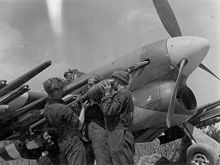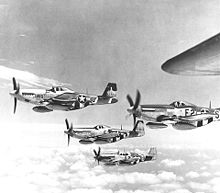
Back Luftkrigen under Operation Overlord Danish Luftkrieg während der Operation Overlord German Opérations aériennes pendant la bataille de Normandie French
This article includes a list of general references, but it lacks sufficient corresponding inline citations. (May 2024) |
The air war during Operation Overlord, alongside the Battle of Britain, the carrier battles in the Pacific and the strategic air war against the German Reich, was one of the most significant air battles of the Second World War. It took place between April and August 1944 in the course of the Allied landings in northern France (→ Operation Overlord).

The Allied landing in Normandy was also made possible by the air superiority of the Allied forces. Before June 6, 1944, known as D-Day, the Allied air forces prepared for the invasion. They bombed German supply lines, artillery batteries and supported the French Resistance from the air with ammunition and equipment.

During D-Day, Allied fighters secured the airspace over the landing area and bomber squadrons attacked German positions in the hinterland. At the same time, Allied aircraft searched the sea for German submarines to protect the Armada and the supply ships. As the Germans had believed in a landing at the Strait of Calais and in some cases still did in June 1944 (? German situation in Normandy in 1944), they were only able to oppose the Allies with a few fighter planes on D-Day. The majority of the units had been moved further inland shortly beforehand.
After D-Day, the Allies supported their offensives on the ground with concentrated bombing. Allied fighter-bombers searched Normandy for German troop units and strafed them to prevent them from being used against the land forces. The German air force was barely able to counter the Allied air forces and the advance on the ground. The German Wehrmacht hoped to repel the invasion with "wonder weapons" such as "Blitzbombers" and jet fighters (which were not used, however), but above all with the deployment of battle-hardened armored divisions. The German Wehrmacht also attacked British cities with the "retaliation weapons" V1 and V2.

The Allied air forces were able to fulfill all the tasks assigned to them, albeit with delays due to bad weather, as in the case of the Battle of Caen. The scale of the forces deployed was unprecedented; the loss of almost 17,000 Allied aircrew in less than three months was the highest human and material sacrifice in the history of the air war. The German air force was unable to decisively counter the Allied superiority. The attempt to halt the Allied advance with a massive counterattack during unfavorable flying weather in the winter of 1944 also failed (Battle of the Bulge, Operation Bodenplatte).
© MMXXIII Rich X Search. We shall prevail. All rights reserved. Rich X Search